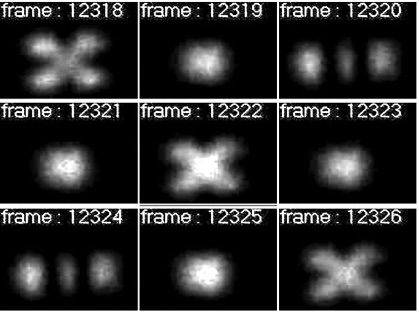

Nonlinear Dynamics
Extreme events in a self pulsing Nd: Vanadate laser with saturable absorber
The passively Q-switched, self-pulsing all-solid-state laser is a device of widespread use in many applications. Depending on the condition of saturation of the absorber, which is easy to adjust, different dynamical regimes are observed: continuous-wave emission, stable oscillations, period doubling bifurcations, chaos, and, within some chaotic regimes, extreme events (EEs) in the form of pulses of extraordinary intensity. These pulses are sometimes called “dissipative optical rogue waves.” The mechanism of their formation in this laser is unknown. Previous observations suggest they are caused by the interaction of a few transverse modes. Here we report a direct observation of the pulse-to-pulse evolution of the transverse pattern. In the periodical regimes, sequences of intensities are correlated with sequences of patterns. In the chaotic ones, a few different patterns alternate, and the EEs are related with even fewer ones. In addition, the series of patterns and the pulse intensities before and after an EE are markedly repetitive. These observations demonstrate that EEs follow a deterministic evolution, and that they can appear even in a system with few interacting modes. This information plays a crucial role for the development of a mathematical description of EEs in this laser. This would allow managing the formation of EE through control of chaos, which is of both academic and practical interest (laser rangefinder).

An example of the sequence of an EE. It is, in addition, curiously symmetrical in time. The EE is frame 12322.
Algorithmic complexity in chaotic lasers
The canonical way to determine, from a time series, if a system, for example the output of a laser, is chaotic, is through the reconstruction of the attractor, based on Takens' theorem. In this way, from a time series it is possible to reconstruct the attractor of the system and derive its properties from there. However, in practice, there are drawbacks. The time series may be too short, or even being of adequate size it may evolve over a very limited region of the attractor. These factors cause the reconstruction to fail. On the other hand, even when reconstruction is feasible, can be not the best option, for example if the objective is to implement a system control scheme.
For these reasons we search for mathematical tools that allow a rapid diagnosis on experimental time series.
Kolmogorov defines the algorithmic complexity of a sequence x, as the information (in bits) of the shortest program running on a Universal Turing Machine (UTM) whose output is the sequence x. With this definition, a random series has maximum complexity, since the shortest way to describe it is by enumerating each of its components. Kolmogorov associates randomness with compressibility. A periodic sequence is very compressible, it is enough to describe its period to obtain the complete sequence. Chaotic series are halfway between periodic and random, with medium complexity.
Kolmogorov's definition is conceptually very elegant and easy to understand, but it suffers from a serious problem: it is incomputable. By Gödel's Incompleteness Theorem, it cannot be shown that a program is the shortest to describe a certain sequence.
So, from the compressibility algorithm of Lempel and Ziv and the version of Kasper and Schuster , we use a quantity Kc developed for Prof. D. Mihailovic from the University of Novi Sad, Serbia. Kc quantifies the compressibility and is proportional to the Kolmogorov complexity.
With this complexity, Kc, we studied experimental time series from Ti:Sapphire, Nd:Vanadate with saturable absorber and Nd:Vanadate with loss modulation. For all of them we determined their complexity and based on it we quantify the chaoticity of the system, as well as a prediction horizon parameter (similar to Lyapunov) based on Kc.
Random number generation with chaotic lasers
The generation of random numbers is a field of great development throughout the world. Random number sequences are a critical input in different fields of science and technology. From numerical simulations to secure communications and key distribution, it is used daily in many fields. The degree of randomness required in each application is different. For example, in a numerical simulation, pseudo-random sequences generated by any computer algorithm may not only suffice, but sometimes repeatability is a desirable quality in calculation verification. This property is, on the contrary, intolerable, in cryptographic applications, for obvious reasons.
Among the generators based on physical phenomena, quantum are the ones that claim to be the only that generate true randomness. Beyond the theoretical discussions in this regard, which will also be studied, from a practical point of view, they imply carrying out a Bell loophole free experiment, extremely difficult to carry out, extremely expensive and with which only a few bits of randomness are obtained, since it consumes most of the sequence in certifying the randomness. For these reasons, it is clear that generating randomness in this way is not feasible in real situations, outside the laboratory, both for cost and implementation reasons.
Our proposal is to generate randomness based on a chaotic compact solid laser. Random number generators based on chaotic lasers are not a novelty, there have been a large number of devices based on this principle for a decade. They are based mostly on laser diodes with external feedback. This kind of device is easily coupleable to fiber and have a very high repetition rate, which makes them particularly adaptable to medium and low security communications systems.

